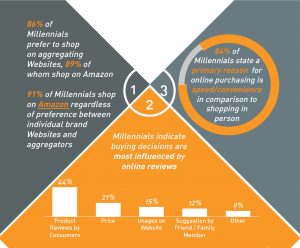The Importance of eCommerce in a Rapidly Changing Retail Environment
Consumer shopping trends continue to rapidly evolve, as Amazon and other eCommerce retailers’ presence continues to grow and change versus the traditional retail model. According to the Census Bureau of the Department of Commerce, Q2’16 retail eCommerce sales increased 15.8% year-over-year, and accounted for 8.1% of total retail sales, an increase of 1 percentage point from Q2’15. Moreover, digital commerce research firm eMarketer, forecasts that as a percentage of total U.S. retail sales, eCommerce will continue to increase over the next five years, reaching 13.6% of total retail sales by 2021.
As eCommerce sales continue to take a larger piece of the total retail pie, brand relevance and lasting success are becoming ever more dependent on an online presence. However, brands and retailers looking to grow revenue and capture a portion of the growing eCommerce market do not need to appeal to a vast group of consumers. On the contrary, brands and retailers should strategically target a concentrated cluster of consumers for maximum results. A recent study conducted by Worldpay revealed that 87% of all monthly eCommerce spending on physical goods is done by a demographic that accounts for a mere 13% of the population—Millennials.
In the past 12 months ending August 2016, Millennials spent approximately $340 billion on consumer goods, a stark comparison to the $210 billion spending completed by the remaining 87% of the general population. Millennials, individuals born between 1980 and 2000, comprise the biggest generation in U.S. history, even greater in size than Baby Boomers. This demographic influences older generations and are trendsetters across all industries from apparel to health and wellness.
Redefining the retail environment as we know it, Millennials’ purchasing power and spending habits are revolutionizing the shopping experience, forcing brands and retailers to reevaluate how they interact with consumers.
Growing up in an environment heavily focused on online content, Millennials’ affinity for apps, smartphones and technology is rapidly influencing the retail space. With instantaneous access to product information, product reviews and price comparisons, Millennials are seeking out brands and retailers that can offer maximum convenience. Redefining the retail environment as we know it, Millennials’ purchasing power and spending habits are revolutionizing the shopping experience, forcing brands and retailers to reevaluate how they interact with consumers.
In an effort to better understand this demographics’ eCommerce spending habits, Intrepid’s Apparel & Retail team conducted a survey targeting consumers between the ages of 19 and 34. The survey found that over 50% of Millennials purchase products online on a monthly basis, while 30% find themselves purchasing products weekly. The majority of Millennials do not foresee a change in the frequency of their online shopping habits. However, of the group that anticipates a change in behavior, 88% expects an increase in the frequency of their online shopping. When asked to share the primary reasons that drive purchases in either retail stores or on eCommerce platforms:
- 84% indicated speed and convenience of online purchases as opposed to shopping at the retail location
- 58% indicated that purchasing products online was cheaper than buying in retail stores
- Only 9% of Millennials stated a preference for shopping at retail stores, with women accounting for an overwhelming majority of those indicating a preference of shopping at brick and mortar.

While many retailers have invested heavily in mobile optimization, over 98% of participants stated that they still use either a laptop or desktop as one of their methods for making eCommerce purchases. In addition, consumers are most likely to engage with advertisements made through the form of product recommendations from influencers or individuals followed on social media. The counterbalance to this point is that brand awareness generated from organic users of a product carries a much higher value to the consumer in comparison to endorsements from “paid influencers”.
Read Intrepid’s Millennials Spending Habits Survey



